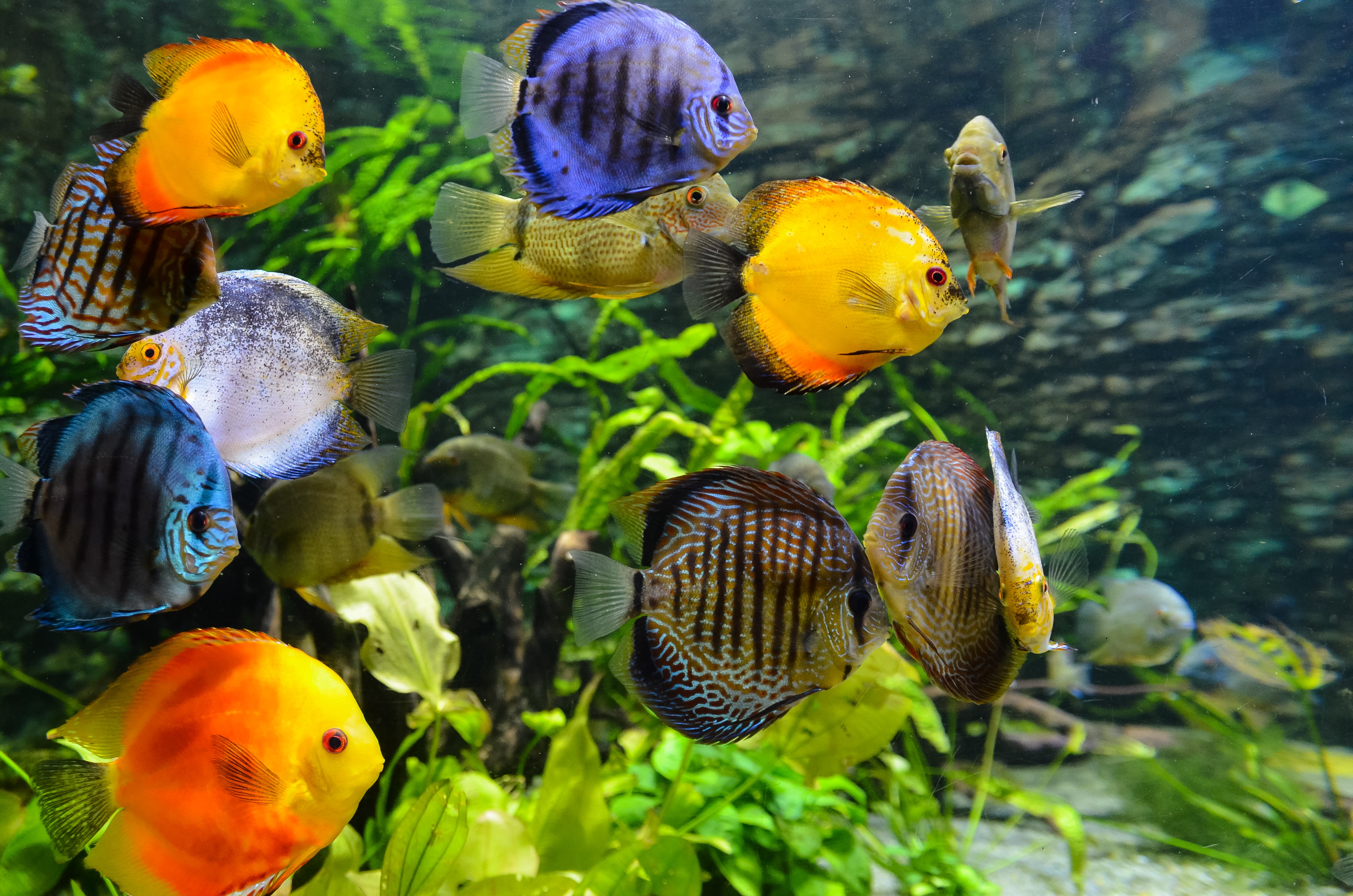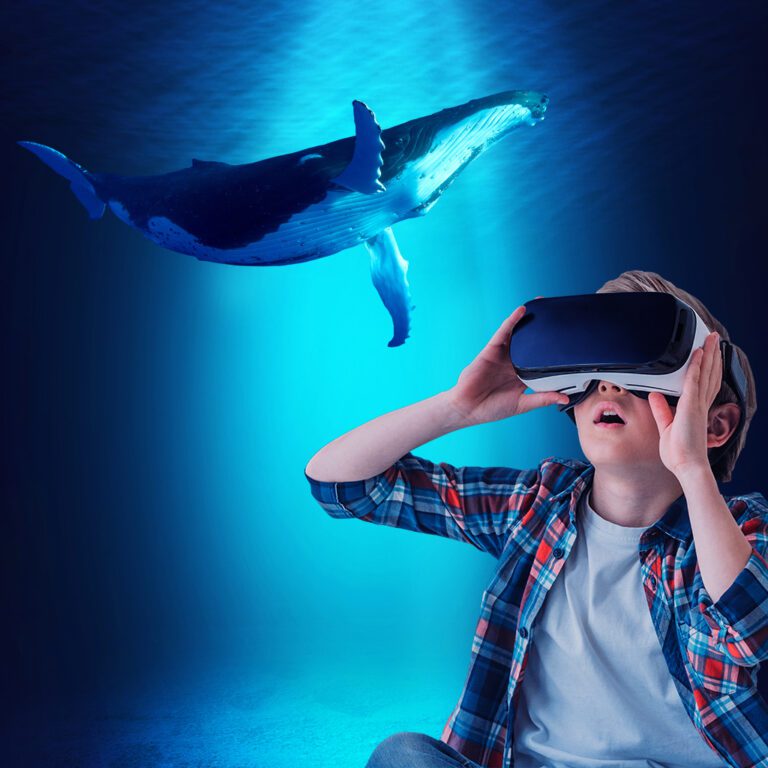
The species in our freshwater exhibits are residents of local and global streams, rivers, and lakes. The plants, animals, microbes, rocks, soil, sunlight, and water found in and around these precious resources are part of a freshwater ecosystem.
Scientists who study freshwater ecosystems are called limnologists. The term “limnology” originated from the ancient Greek word limne, meaning lake or pond. So, it is literally the study of lakes and ponds. Like oceanography, limnology is a complex integrative science where physics, chemistry, and biology interact. Limnologists want to learn how freshwater creatures live in an ecosystem, how they act together through the ecosystem’s food web, and how they interact with their environment.

Our state-of-the-art aquarium will offer an immersive experience with a wide range of freshwater aquatic species, from bass to walleye and red cherry shrimp.
Although these ecosystems accommodate a wide variety of fish, amphibians, mollusks, crustaceans, and insects, they are exceptional habitats for large numbers of resident and migratory birds.
In addition, the United States has most of the world’s surface freshwater resources. As a result, more than eight hundred known freshwater fish species are in the U.S. With interactive exhibits, you will explore and learn more about each species in their natural habitats.
![]()
Rivers in the Midwest, including the Rock River, can be looked at as open systems, which means they are affected by outside factors. They are free flowing from their headwaters and throughout the entire watershed as they travel downstream, as in the case of the Mississippi. No matter where you look, there will be something unique to see at Rockford Aquarium! Our stunning panoramic digital exhibit views will provide an unparalleled experience for visitors of all ages.
The freshwater of our lakes and rivers’ underwater world at Rockford Aquarium will have ongoing interactive activities and spectacular learning opportunities that will leave you mesmerized and wanting more. Freshwater is a scarce resource on Earth. Less than three percent of the water on Earth is freshwater, and the remaining ninety-seven percent is salt water, such as in our oceans.
Get ready for an unforgettable experience with our freshwater fish exploration! With interactive activities that let you observe and learn about marine life, you can get up close and personal with the majestic lifeforms in our rivers and streams. For a unique and eye-opening experience, you can explore the wonders of freshwater fish with us!
![]() Our interactive activities let you get up close and personal with freshwater and marine life while exploring the unique habitats they inhabit. The habitats that freshwater ecosystems provide consist of lakes, rivers, ponds, wetlands, streams, and springs. You will learn about these fascinating creatures by taking part in our educational activities, such as learning about biodiversity and the variety of life found in freshwater habitats on Earth. For example, when most of us think of dolphins, we think of them in the ocean. But, surprisingly, a few species of dolphins have adapted to life in freshwater—either entirely or partially. Freshwater dolphins are primarily found in Asia and South America in some of the busiest rivers. Like us, dolphins can decipher problems and form complex social groups. You will learn about freshwater dolphins, which will be an experience like no other – so don’t miss out on this adventure of a lifetime.
Our interactive activities let you get up close and personal with freshwater and marine life while exploring the unique habitats they inhabit. The habitats that freshwater ecosystems provide consist of lakes, rivers, ponds, wetlands, streams, and springs. You will learn about these fascinating creatures by taking part in our educational activities, such as learning about biodiversity and the variety of life found in freshwater habitats on Earth. For example, when most of us think of dolphins, we think of them in the ocean. But, surprisingly, a few species of dolphins have adapted to life in freshwater—either entirely or partially. Freshwater dolphins are primarily found in Asia and South America in some of the busiest rivers. Like us, dolphins can decipher problems and form complex social groups. You will learn about freshwater dolphins, which will be an experience like no other – so don’t miss out on this adventure of a lifetime.

Get ready for a bevy of prominent components to make your visit unforgettable. With A.I.-powered virtual user interactive experiences, augmented reality technology, and engaging exhibits – freshwater and saltwater – you’ll be immersed in an educational journey. These learning journeys cultivate learning environments that will focus on a collaboration of interests with educators, experts, and artisans interpreting digital interactive destinations worldwide. From STEM teaching labs to crucial exhibits, you will experience the future of exploration with the Rockford Aquarium. You will witness the fantastic integration of Artificial Intelligence (A.I.) as you traverse through the virtual world and get up close and personal with our fresh and saltwater tanks. With augmented reality technology, your journey will be a truly immersive one. Step into a world of discovery at the Rockford Aquarium and learn about the wonders of aquatic life while being entertained. You’ll be surrounded by stunning marine life and know more about the environment than you ever thought possible.
Populations of channel catfish, walleye, northern pike, largemouth and smallmouth bass, sauger, white bass, bluegill, flathead catfish, drum, and bullheads can be found as part of the biodiversity of the regional ecosystem. The Rockford Aquarium intends to interpret and help create an appreciation for marine life and inspire conservation efforts of The Rock River Valley, particularly the Rock River, which flows through it. Throughout the Freshwater Exhibit Space, we will show how and why The Valley provides a safe environment for fish and other aquatic creatures while allowing visitors to observe them in their natural habitat. As a result, visitors can better understand freshwater’s fragile state and become more aware of how human activities can impact our rivers, streams, and lakes.
River systems are the geographical zone with the highest biological diversity and our most intense human activity. In the Heartland of the Midwest, the Rock River in the Rock River Valley is no exception.
The Rock River is considered a Mississippi River tributary, is approximately 299 miles, and travels from Wisconsin to Illinois. Our river was known as the “Sinnissippi” to Sauk and Fox Indians. The name means “Rocky Waters.” The Rock River, which winds 155 miles through northwestern Illinois, provides a diverse freshwater habitat. Walleyes, Sauger, and White Bass call the river home. The river also provides an aquatic resource of about 12,400 acres as it glides past the towns of Rockford, Oregon, Dixon, Sterling, and Rock Island before entering the Mississippi.
The Rock River Valley is a region in Northern Illinois comprised mainly of the communities along and in close proximity to the Rock River, a major tributary of the Mississippi River. The Rock River Valley area is also rich in biodiversity. Boone, DeKalb, Ogle, Stephenson, and Winnebago Counties boast spectacular savannas, elegant grasslands, and magnificent woodlands.
The river begins with three separate branches which flow into the Horicon Marsh. The Rock River West Branch’s northernmost branch begins just to the west of the village of Brandon in Fond du Lac County, Wisconsin, and flows east and then south to Horicon Marsh. The silted-up glacial lake is the largest freshwater cattail marsh in the United States.
The Rock River South Branch rises north of Fox Lake in Dodge County and flows east through Waupun to the marsh. Theresa Marsh Wildlife Area includes nearly 5,500 acres of state-owned lands and 300 acres of publicly accessible easements in northwestern Washington and northeastern Dodge counties.
The Rock River East Branch grows from the southeast of Allenton in Washington County just west of the Niagara Escarpment and flows north and west through Theresa to the marsh. The East Branch of the Rock River flows north through the core of the wildlife area. Wetlands, primarily emergent marsh and bottomland hardwood forest, border the river and cover 80% of the property. Uplands are a mix of grassland, farmland, and upland hardwood forest.
One of the Aquarium’s critical educational goals is to give a new generation of young people what they truly need to thrive in our society, a new paradigm of learning and educating about our water environment and the fragile echo system.
The Aquarium’s Empowerment Education Exhibits will provide a framework and principles to shift through an inside-out, top-down, integrative approach to change and greater understanding. These guiding principles will be part of our educational curriculum decisions, teaching methodologies, environmental set-up, and building fun-filled interpersonal relationships Throughout our interactive freshwater exhibits. The Aquarium’s guided freshwater inquiry for our young visitors has the highest potential to improve the students’ scientific thinking skills and better understand the world in which we live.
THE ROCKFORD AQUARIUM OUTCOMES OF EDUCATIONAL EMPOWERMENT
The Rockford Aquarium is an institution of learning to strengthen environmental literacy and to provide an example of what it means to be sustainable.
It will be a hybrid of natural history museum, aquarium, and science center.